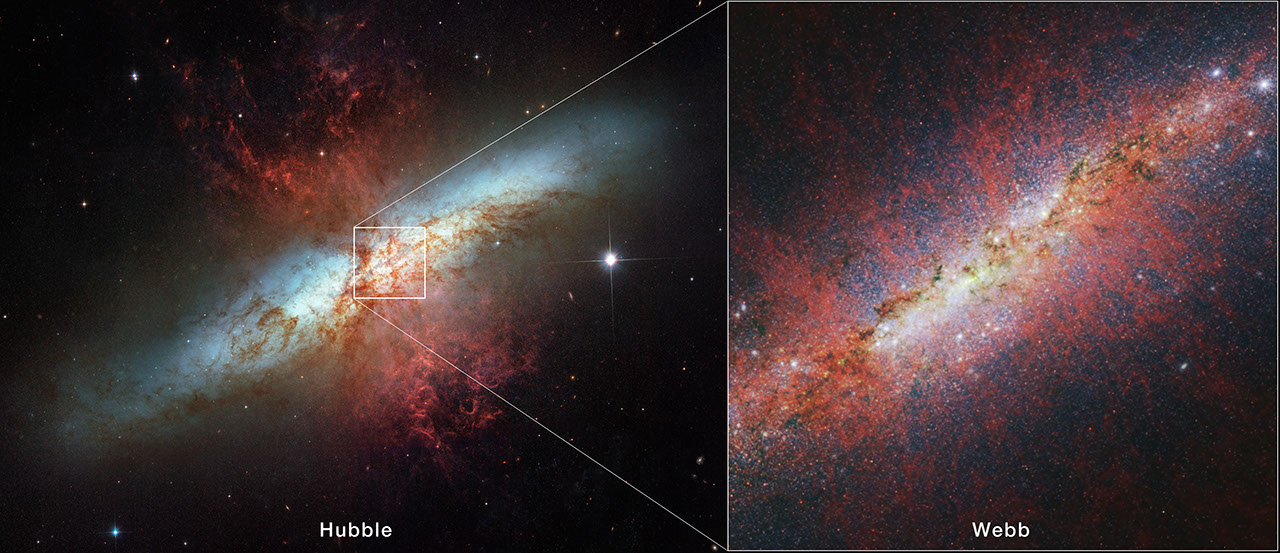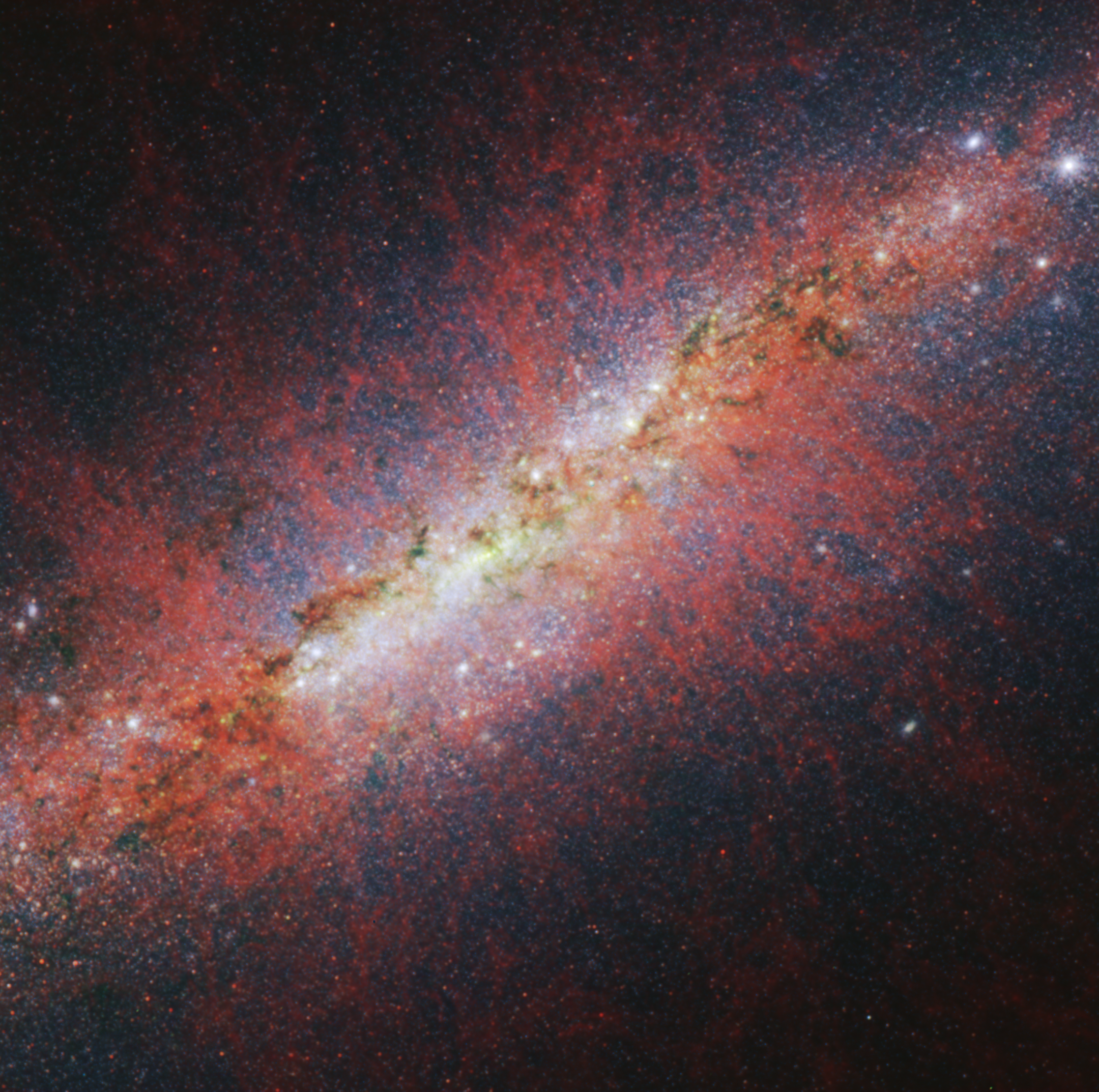1 min read
M82 (Hubble and Webb Compass Image)

Annotated image of the starburst galaxy Messier 82 captured by Webb's NIRCam (Near-Infrared Camera) instrument, with compass arrows, a scale bar, and color key for reference.
The north and east compass arrows show the orientation of the image on the sky. Note that the relationship between north and east on the sky (as seen from below) is flipped relative to direction arrows on a map of the ground (as seen from above).
The scale bar is labeled in light-years.
This image shows invisible near-infrared wavelengths of light that have been translated into visible-light colors. The color key shows which NIRCam filters were used when collecting the light. The color of each filter name is the visible light color used to represent the infrared light that passes through that filter.
Extended Description and Image Alt Text
Extended Description
Annotated Image titled “James Webb Space Telescope, The Cigar Galaxy, M82,” with compass arrows, scale bar, and color key.
Image
Left: Messier 82 as imaged by NASA's Hubble Space Telescope. Hour-glass-shaped red plumes of gas are shooting outward from above and below a bright blue, disk-shaped center of a galaxy. This galaxy is surrounded by many white stars and set against the black background of space. A small square highlights the section that the image on the right shows in greater detail. White text at bottom reads "Hubble."
Right: A section of Messier 82 as imaged by NASA's James Webb Space Telescope. An edge-on spiral starburst galaxy with a bright white, glowing core set against the black background of space. A white band of the edge-on disk extends from lower left to upper right. Dark brown tendrils of dust are scattered thinly along this band. Many white points in various sizes – stars or star clusters – are scattered throughout the image, but are most heavily concentrated toward the center. Many clumpy, red filaments extend vertically above and below the galaxy’s plane. White text at bottom reads "Webb."
Compass Arrows, Scale Bar, and Color Key
At the top left are compass arrows indicating the orientation of the image on the sky. The north arrow points in the 10 o’clock direction. The east arrow points toward 7 o’clock. In the top left corner is a scale bar labeled 7,500 light-years. Below the image is a color key showing which NIRCam filters were used to create the image and which visible-light color is assigned to each filter. From left to right, NIRCam filters are: F164N is cyan; F250W is green; and F335M is red.
Image Alt Text
Annotated image of the starburst galaxy Messier 82 captured by Webb's NIRCam (Near-Infrared Camera) instrument, with compass arrows, a scale bar, and color key for reference. At left is Messier 82 as imaged by NASA's Hubble Space Telescope. A small square highlights the section that the image on the right shows in greater detail. White text at bottom reads "Hubble." At right, a section of Messier 82 as imaged by NASA's James Webb Space Telescope. An edge-on spiral starburst galaxy with a bright white, glowing core set against the black background of space. White text at bottom reads "Webb." In the upper left corner, a scale bar is labeled 7,500 light-years.
About the Object
- R.A. PositionR.A. PositionRight ascension – analogous to longitude – is one component of an object's position.09:55:52.0
- Dec. PositionDec. PositionDeclination – analogous to latitude – is one component of an object's position.69:40:48.99
- ConstellationConstellationOne of 88 recognized regions of the celestial sphere in which the object appears.Ursa Major
- DistanceDistanceThe physical distance from Earth to the astronomical object. Distances within our solar system are usually measured in Astronomical Units (AU). Distances between stars are usually measured in light-years. Interstellar distances can also be measured in parsecs.12 million light-years (3.7 Megaparsecs)
About the Data
- Data DescriptionData DescriptionProposal: A description of the observations, their scientific justification, and the links to the data available in the science archive.
Science Team: The astronomers who planned the observations and analyzed the data. "PI" refers to the Principal Investigator.Left Image: This image was created from HST data from proposal 10776 M. Mountain (STScI), J. Gallagher (University of Wisconsin-Madison), P. Puxley (NSF), K. Noll, H. Bond, C. Christian, L. Frattare, F. Hamilton, Z. Levay, M. Mutchler, W. Januszewski, and T. Royle (Hubble Heritage Team/STScI/AURA)
Right Image: This image was created with Webb data from proposal: 1701 (M. Marin). Image processing: Alyssa Pagan (STScI).
- InstrumentInstrumentThe science instrument used to produce the data.HST>ACS/WFCJWST>NIRCam
- Exposure DatesExposure DatesThe date(s) that the telescope made its observations and the total exposure time.27-29 March 2006, 5 Janurary 2024
- FiltersFiltersThe camera filters that were used in the science observations.HST> F435W, F555W, F658N, F814WJWST> F164N, F250W, F335M
- Object NameObject NameA name or catalog number that astronomers use to identify an astronomical object.M82, NGC 3034
- Object DescriptionObject DescriptionThe type of astronomical object.Starburst Galaxy
- Release DateApril 3, 2024
- Science ReleaseNASA’s Webb Probes an Extreme Starburst Galaxy
- CreditImage: NASA, ESA, CSA, STScI, Alberto Bolatto (UMD)

Left Image: This image is a composite of many separate exposures made by the ACS instrument on the Hubble Space Telescope using several different filters. Three filters sample broad wavelength ranges, one isolates the light of hydrogen. The color results from assigning different hues (colors) to each monochromatic image. In this case, the assigned colors are: Blue: F435W, Green: F555W, Red-orange: F658N Red: F814W Right Image: This image is a composite of separate exposures acquired by the James Webb Space Telescope using the NIRCam instrument. Several filters were used to sample varying wavelength ranges. The color results from assigning different hues (colors) to each monochromatic (grayscale) image associated with an individual filter. In this case, the assigned colors are: Blue: F164N, Green: F250W, Red: F335M
Related Images & Videos

M82 (Hubble and Webb)
Starburst galaxy M82 was observed by the Hubble Space Telescope in 2006, which showed the galaxy’s edge-on spiral disk, shredded clouds, and hot hydrogen gas. The James Webb Space Telescope has observed M82’s core, capturing in unprecedented detail the structure of the galactic...
Share
Details
Laura Betz
NASA’s Goddard Space Flight Center
Greenbelt, Maryland
laura.e.betz@nasa.gov
NASA, ESA, CSA, STScI, Alberto Bolatto (UMD)

































